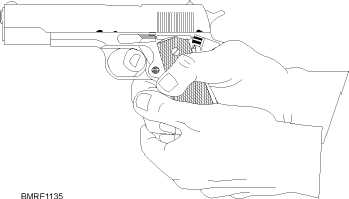looking straight out through your shooting eye. Keep
your shooting arm fully extended.
In the one-handed position, the shoulder of your
shooting hand should be slightly raised. Turn your head
in order to see the target through the sights. The ease
with which your head can be turned is another
determining factor in how far you must turn to the right
or left. There should be no strain on the neck muscles
with your head held upright. The whole position, with
the exception of your shooting arm, is one that can be
maintained with the least muscular effort. Your body is
balanced, rather than held in position. The muscles of
your shooting arm and shoulder should be tightened
somewhat to sustain the weight of the pistol and to
maintain a correct grip. Excessive tightening of the
muscles of your shooting arm and hand should be
avoided. The tension in the muscles of your shooting arm
and hand should be maintained after the hammer falls.
This will assist in getting off your second shot quicker.
Because of the differences in the body structure of
individuals, the standing position will vary slightly.
However, regardless of your size, your position should
be relaxed and comfortable. The pistol should point at
the center of the target or you will be tense while firing. If
you are tense, there will be excessive muzzle movement.
Trigger Squeeze
Poor shooting is most often caused by disturbing
your aim as the bullet is leaving the barrel. This is usually
the result of jerking the trigger or flinching. The trigger
does not have to be jerked violently to spoil your aim;
even a slight off-center pressure of your finger while
squeezing the trigger is enough to move the strike of the
bullet several inches.
Flinching is a subconscious reflex caused by
anticipating the recoil from firing.
Jerking results from attempting to fire the pistol at
the precise time that you align the sights with the
target.
Heeling causes the bullet to strike the target high
and to the right.
You can correct all these shooting errors by
understanding and using the correct trigger squeeze.
Both flinching and jerking will cause the bullet to strike
the lower left section of the target. An attempt to correct
flinching and jerking by tightening the large muscle in
the heel of the hand may cause heeling. An improper
trigger squeeze will cause more misses on the target than
any other single step of preparatory marksmanship
training.
You obtain a correct trigger squeeze by applying a
uniformly increasing pressure on the trigger straight to
the rear without disturbing the sight alignment until the
pistol fires. The trigger slack, or free play, is taken up
first, and the correct squeeze continues steadily until the
hammer falls. If the trigger is squeezed properly, you
will not know when the hammer will fall. This is the best
way to prevent jerking, flinching, and heeling.
To help you squeeze the pistol trigger properly, use
the acronym BRASS as you did with the rifle. You must
also learn to call your shots. If you cannot call your shots
11-23
Student Notes:
Figure 11-35.—Two-hand grip.


